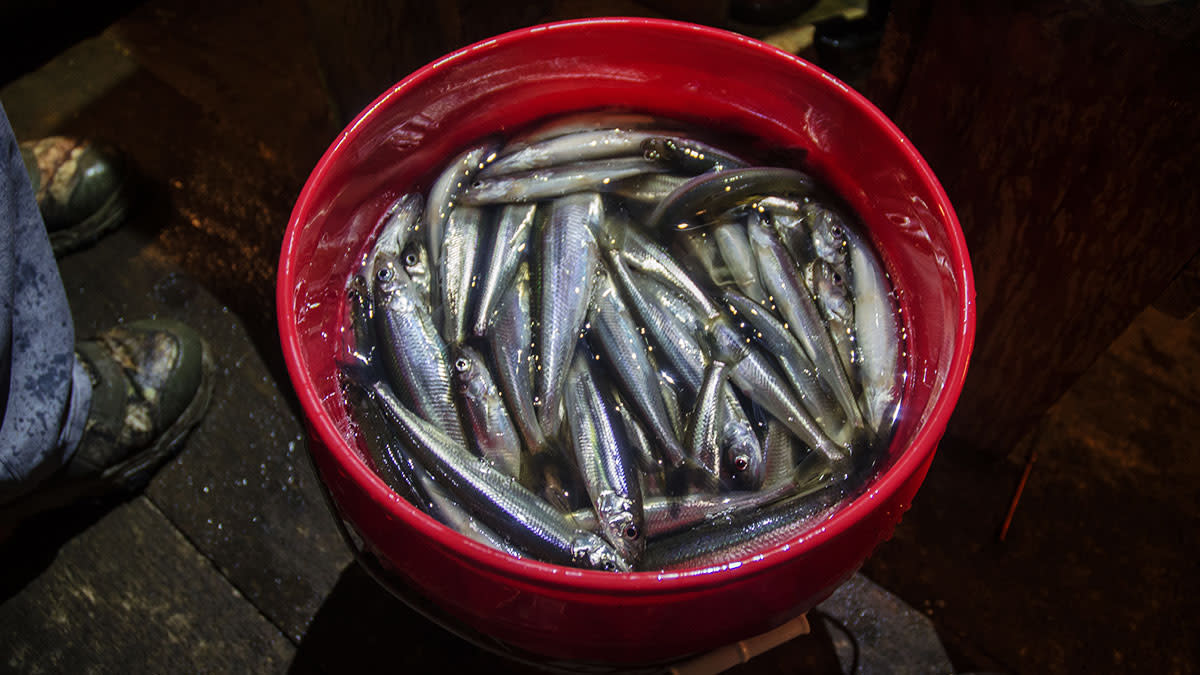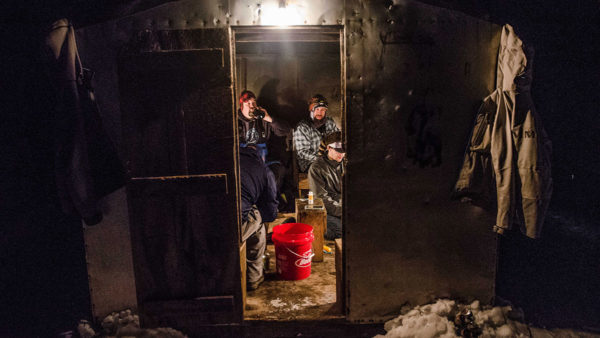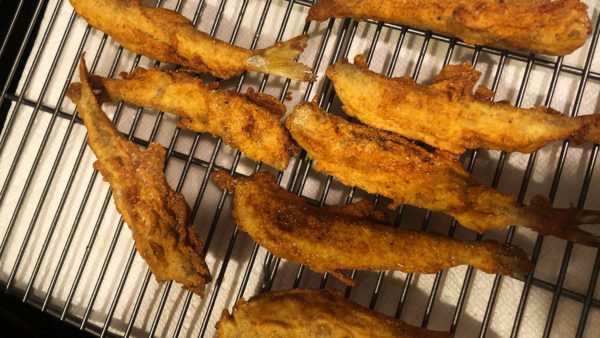
By the third hour of our six-hour smelt shack rental, I’ve come to reconsider the true reason fishermen willingly spend frigid winter nights on fluctuating tidal ice in Maine. If you were to peek in at this point, you’d see a half-full bucket of smelt, a half-empty liter of brandy, and Andy Nabreski halfway through a dirty limerick, while the rest of us laugh, nip the bottle, rebait, and reel in fish.
Our motivation—as told to non-anglers—for targeting these tiny players on a frozen river was the promise of breaded and fried smelt, slathered in tartar sauce, and consumed without utensils or side dishes. But, as the night wears on, I begin to see the smelt as almost incidental. These small, tasty fish are merely an excuse to rebel against the long, cold New England winter nights.
Historically Speaking
There are several species of smelt in the U.S., such as the eulachon or candlefish in the Pacific Northwest. Rainbow smelt were introduced to the Great Lakes in the early 1900s and have since been stocked in inland bodies of water across the country as a forage species. In Maine, we’re after true sea-run rainbow smelt, which once returned in vast numbers to many Northeast and mid-Atlantic rivers and bays. In addition to the smelt shacks, fishermen also suspend lights over docks inside the bays and catch them with baited hooks and dip nets. A few diehards continue this practice, but as with too many anadromous species, dams have taken a heavy toll on smelt, and they’ve vanished from many rivers. A century ago, they ranged as far south as the Chesapeake Bay; today, the southernmost run is in Massachusetts.
And for that reason, if you live outside New England, or even outside Maine, there’s a strong chance you’ve never heard of smelt camp. These pop-up fishing outposts appear on the frozen brackish tributaries of the Kennebec River every January, and for generations of fishermen, gathering in the cramped shacks to catch tiny fish has been a rite of winter.
It’s a ritual I’d never participated in until this past February, when Nabreski and my other co-worker Eddy invited me and fellow uninitiated smelters Adam and Mike to join them on their annual trip to the James Eddy Smelt Camp. James Eddy is one of seven camps operating on Kennebec tributaries. Each one has shacks that you can rent by the tide, so our 2:30 p.m. reservation for the incoming will take us through sunset to almost 9:00 p.m.

As we pull into the dirt parking lot, the ebb tide has just slacked and the previous ice shack tenants are being evicted. Most of the anglers are exactly who I expect—flannel- and Carhartt-clad men in their middle and later years—but I’m shocked when a bachelorette party, complete with sash-wearing bride-to-be, emerges from one of the shacks.
Before hitting the ice, we check in at the “office,” which is just a woodstove-warmed trailer surrounded by snowmobile parts and dismantled smelt shacks. My eyes drift to the electrical system, a tangle of wires running from the trailer to a scraggly fallen tree haphazardly jammed into the ice at the riverbank. From this makeshift power pole, the wires branch out to every shack.
Inside the trailer taking money and selling bait is camp manager Ray Crayford. In addition to being the heater repairman, graffiti cleaner, ice-chipper, and occasional referee at James Eddy, Crayford also digs bloodworms—a fact he reveals after upselling us on a second dozen of the squirming, dollar-apiece annelids.
We descend a steep ramp to the ice. It’s low tide now, and when our fishing session is over in six hours, that same ramp will be almost fully horizontal. I can already hear the ice cracking along the bank as the rising tide begins to lift us.
Team Building
We’ve been assigned to Shack Number 10, the second-to-last one in the row. Walking by the others, you get a sense of the personalities inside each feeble dwelling. Shack Number 6 looks and smells like a Patriots tailgate party. There are empty Bud Light cans by the door and the scent of grilling kielbasas wafting out. Shack Number 7 smells like a Phish concert. No two shacks are exactly the same size nor made from the same combination of materials. We quickly learn that the six-man unit we’ve reserved is quite cozy with all five of us in there.
Inside, there’s a crude raised wooden floor surrounding the 1-foot by 8-foot hole cut in the ice. The shack is lit by a string of light bulbs, their glow reflected toward the water by sculpted tin foil and empty beer cans shades. There are six wooden stools and a propane heater that’s doing its job too well, so we move it outside. Faded graffiti decorates the metal walls, and I can just make out the scoreboard of a previous group, who had divided themselves into two teams: The Good Guys and the Bad Guys. I count the hash marks and learn that the Bad Guys won by a narrow margin.
As we begin to unpack, we discover that we’d left the Allen’s Coffee Brandy in the truck, and I volunteer to retrieve it. Andy has informed me that this is an essential libation for ice fishing in Maine. For more than 15 years, the coffee-flavored liqueur was the best-selling spirit in the state, until 2018, when it was dethroned by Fireball Cinnamon Whisky. By the time I return from the truck, there are a half-dozen smelt in our bucket. I uncap the Allen’s, take a swig, pass it on, and get to fishing.
Rainbow smelt spend most of their lives in the ocean and return to freshwater rivers to feed and reproduce. The spawn happens shortly after ice-out, which occurs on Maine’s tidal rivers between mid-March and early April. When the smelt first enter the rivers in winter, their primary goal is to fatten up. These fish have big mouths for their size, and feed on a variety of smaller baitfish and invertebrates. Even though an 8-incher would be considered a trophy, these mini fish are predators, and to their get attention, you have to keep the baits moving.
After adding a piece of bloodworm to each of the three hooks on my Sabiki rig, I lower it to the riverbed. Mike, who was responsible for all the smelt already in the bucket, tells me that the fish are a couple feet off the bottom, so I reel in two cranks, jig a couple times, and get bit instantly.
I reel my first smelt to the surface and take it outside for a better look. In the fading light, it’s easy to see how it earned its name. Unlike the gradients on a rainbow trout, a smelt’s rainbow colors are almost prismatic, reflecting an array of pinks, purples, golds, and greens as I turn the fish in the sunset. As I admire my catch, Mike’s shout of “double-header!” reminds me there’s a bucket to fill and roughly five hours to do it.

Crunching Numbers
The possession limit for smelt is measured by volume rather than number of fish. Anglers are allowed to keep four quarts of smelt per day, which means our group will have to top off our 5-gallon bucket to limit out. Smelt are a coveted food fish in many cultures. They can be prepared many ways, but for most Mainers, simple frying is the method of choice. You just slit the belly and remove the guts, cut off the head, toss the fish in seasoned flour, and drop it in hot oil—bones and all. They’re more flavorful than perch or walleye, but not at all fishy, and the backbone and fins give them a satisfying crunch.
As the sun goes down and the tide picks up, the fishing catches fire. We begin bailing smelt at a steady clip. There are rarely more than three of us fishing at once, as we alternate between jigging and cutting worms. The bucket is filling as quickly as the brandy is draining. Our neighbors regularly visit, bearing gifts of food, booze, and fishing intel, and we try to be neighborly by returning the favors. A delegate from dank Shack 7 comes in and rattles off how many smelt each of them had caught. Their total was pushing 550.
By the time our flood tide slacks, I’ve come to fully appreciate the smelt camp tradition and feel a little sad that, according to Crayford, its popularity is fading. In the glory days he says shacks were rented all through the night, even on weekdays. He’d arrive at the camp early in the morning to see old timers walking off with full buckets post-graveyard shift. Like many other dying scenes in the outdoors, Crayford points a finger at technology, suspecting that the nearly unlimited entertainment options at our fingertips have made Mainers less willing to spend a night outside in the dead of winter.
For now, at least, smelt camp has gained five new disciples, and in the days that follow our trip, we spread the good word of smelting the best way we know how—by sharing our catch among family and friends. Our crew’s take was 341 fish, which put us well behind the shack 7 team. Maybe they were just in a better headspace than we were. Or maybe the smelt are attracted to Phish.
Featured image by Jimmy Fee





